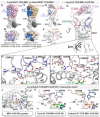This is a preprint.
Human Neonatal MR1T Cells Have Diverse TCR Usage, are Less Cytotoxic and are Unable to Respond to Many Common Childhood Pathogens
- PMID: 40166301
- PMCID: PMC11956999
- DOI: 10.1101/2025.03.17.643805
Human Neonatal MR1T Cells Have Diverse TCR Usage, are Less Cytotoxic and are Unable to Respond to Many Common Childhood Pathogens
Abstract
Neonatal sepsis is a leading cause of childhood mortality. Understanding immune cell development can inform strategies to combat this. MR1-restricted T (MR1T) cells can be defined by their recognition of small molecules derived from microbes, self, and drug and drug-like molecules, presented by the MHC class 1-related molecule (MR1). In healthy adults, the majority of MR1T cells express an invariant α-chain; TRAV1-2/TRAJ33/12/20 and are referred to as mucosal-associated invariant T (MAIT) cells. Neonatal MR1T cells isolated from cord blood (CB) demonstrate more diversity in MR1T TCR usage, with the majority of MR1-5-OP-RU-tetramer(+) cells being TRAV1-2(-). To better understand this diversity, we performed single-cell-RNA-seq/TCR-seq (scRNA-seq/scTCR-seq) on MR1-5-OP-RU-tetramer(+) cells from CB (n=5) and adult participants (n=5). CB-derived MR1T cells demonstrate a less cytotoxic/pro-inflammatory phenotype, and a more diverse TCR repertoire. A panel of CB and adult MAIT and TRAV1-2(-) MR1T cell clones were generated, and CB-derived clones were unable to recognize several common riboflavin-producing childhood pathogens (S. aureus, S. pneumoniae, M. tuberculosis). Biochemical and structural investigation of one CB MAIT TCR (CB964 A2; TRAV1-2/TRBV6-2) showed a reduction in binding affinity toward the canonical MR1-antigen, 5-OP-RU, compared to adult MAIT TCRs that correlated with differences in β-chain contribution in the TCR-MR1 interface. Overall, this data shows that CB MAIT and TRAV1-2(-) MR1T cells, express a diverse TCR repertoire, a more restricted childhood pathogen recognition profile and diminished cytotoxic and pro-inflammatory capacity. Understanding this diversity, along with the functional ability of TRAV1-2(-) MR1T cells, could provide insight into increased neonatal susceptibility to infections.
Keywords: MAIT cells; MR1; MR1T cells; Neonatal sepsis; Single-cell sequencing; T cell development; Tuberculosis.
Conflict of interest statement
Competing Interests J.R. is an inventor on patent applications (PCT/AU2013/000742, WO2014005194; PCT/AU2015/050148, WO2015149130) describing MR1 ligands and MR1-tetramer reagents. The other authors declare no competing interests.
Figures










Similar articles
-
Human Neonatal MR1T Cells Have Diverse TCR Usage, are Less Cytotoxic and are Unable to Respond to Many Common Childhood Pathogens.Res Sq [Preprint]. 2025 Apr 1:rs.3.rs-6265058. doi: 10.21203/rs.3.rs-6265058/v1. Res Sq. 2025. PMID: 40235492 Free PMC article. Preprint.
-
A molecular basis underpinning TRBV28+ T-cell receptor recognition of MR1-antigen.J Biol Chem. 2025 Jun 24;301(8):110416. doi: 10.1016/j.jbc.2025.110416. Online ahead of print. J Biol Chem. 2025. PMID: 40570962 Free PMC article.
-
Mouse mucosal-associated invariant T cell receptor recognition of MR1 presenting the vitamin B metabolite, 5-(2-oxopropylideneamino)-6-d-ribitylaminouracil.J Biol Chem. 2024 May;300(5):107229. doi: 10.1016/j.jbc.2024.107229. Epub 2024 Mar 25. J Biol Chem. 2024. PMID: 38537698 Free PMC article.
-
Signals that control MAIT cell function in healthy and inflamed human tissues.Immunol Rev. 2024 May;323(1):138-149. doi: 10.1111/imr.13325. Epub 2024 Mar 22. Immunol Rev. 2024. PMID: 38520075 Free PMC article. Review.
-
Unconventional T cells in anti-cancer immunity.Front Immunol. 2025 Jul 17;16:1618393. doi: 10.3389/fimmu.2025.1618393. eCollection 2025. Front Immunol. 2025. PMID: 40746558 Free PMC article. Review.
References
-
- World Health Organization. Global Report on the Epidemiology and Burden of Sepsis. 2020.
-
- World Health Organization. Global Tuberculosis Report. 2021
-
- Le Bourhis L, Martin E, Peguillet I, et al. Antimicrobial activity of mucosal-associated invariant T cells. Nat Immunol. 2010;11:701–708 - PubMed
Publication types
Grants and funding
LinkOut - more resources
Full Text Sources
Research Materials
Miscellaneous
